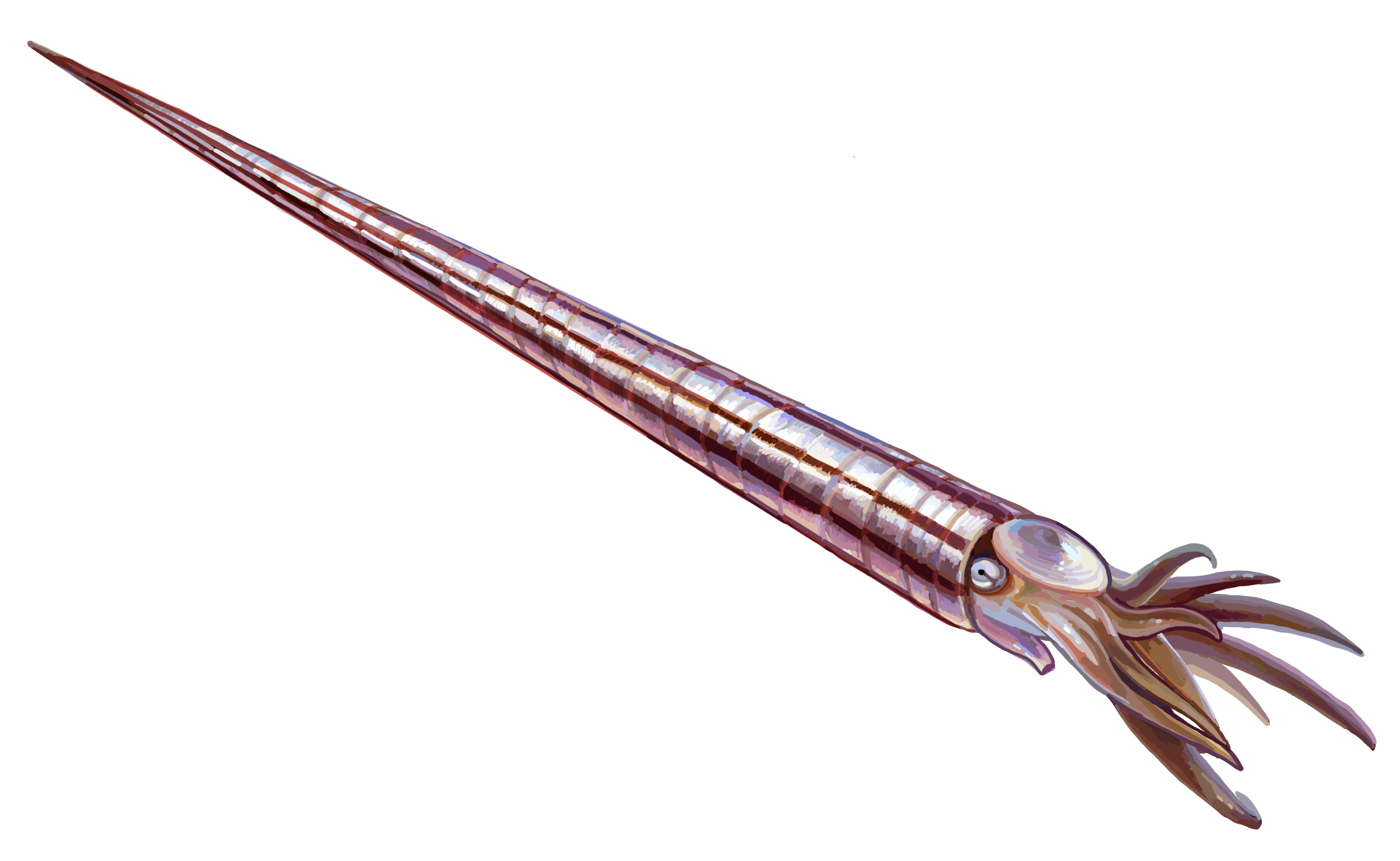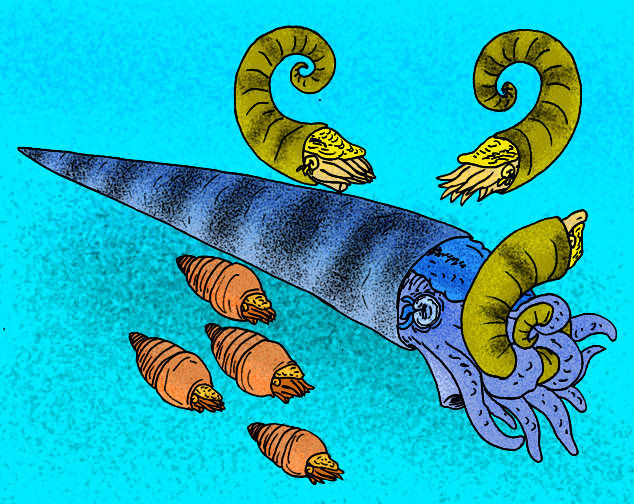|
Endoceratida
Endocerida is an extinct nautiloid order, a group of cephalopods from the Lower Paleozoic with cone-like deposits in their siphuncle. Endocerida was a diverse group of cephalopods that lived from the Early Ordovician possibly to the Late Silurian. Their shells were variable in form. Some were straight (orthoconic), others curved (cyrtoconic); some were long (longiconic), others short (breviconic). Some long-shelled forms like ''Endoceras'' attained shell lengths close to . The related ''Cameroceras'' is anecdotally reported to have reached lengths approaching , but these claims are problematic. The overwhelming majority of endocerids and nautiloids in general are much smaller, usually less than a meter long when fully grown. Morphology Endocerids had a relatively small body chamber as well as a proportionally large siphuncle, which in some genera reached nearly half the shell diameter. This suggests that much of the visceral mass may have been housed within the siphuncle i ... [...More Info...] [...Related Items...] OR: [Wikipedia] [Google] [Baidu] |
Endoceratidae
Endoceratidae is a family of large to very large straight shelled nautiloid cephalopods belonging to the order Endocerida that lived during the Middle and Late Ordovician. They include the largest known Paleozoic invertebrates, represented by '' Endoceras'' and ''Cameroceras''.Teichert C, (1964). Endoceratoidea; Treatise on Invertebrate Paleontology, ''Part K, Mollusca 3''.Flower R. H. (May 1958). "Some Chazyan and Mohawkian Endoceratida", ''Jour Paleo'' 32 (2) pp 433-458 Description Endocerids are characterized by large, generally ventral siphuncles with simple endocones which lack the more complex structures associated with the Proterocameroceratidae and their derivatives. Endocones, nested cone-shaped deposits characteristic of the Endocerida, form in the apical portion of the siphuncle where they balanced the weight of the animal in the body chamber at the opposite end. This helped assure a horizontal orientation while the endoceratid animal was alive. The septal necks are ... [...More Info...] [...Related Items...] OR: [Wikipedia] [Google] [Baidu] |
Proterocameroceratidae
The ''Proterocameroceratidae'' were the first of the Endocerida. They began early in the Ordovician with ''Proendoceras'' or similar genus which had developed endocones, replacing the diaphragms of the ellesmerocerid ancestor. Proterocameroceratids are long, straight or gently curved with a generally narrow siphuncle along the ventral margin. Septal necks are short, never quite reaching the previous septum and may vary in length ontogenically within a species. Connecting rings are thick and layered. Endocones are simple, especially in early forms but may be complex with secondary structures in later forms. The Proterocameroceratidae gave rise to the Piloceratidae early on, and later to the Manchuroceratidae and Chihlioceratidae, from which the Allotrioceratidae are derived, and later yet possibly to the Emmonsoceratidae and Najaceratidae. The Piloceratidae in turn may have given rise to the Endoceratidae although a proterocameroceratid ancestor remains possible. Proterocameroc ... [...More Info...] [...Related Items...] OR: [Wikipedia] [Google] [Baidu] |
Allotrioceras
''Allotrioceras'' is a tubular fossil from the Middle Ordovician of the state of New York, collected by Rousseau H. Flower; included by him in the Endocerida and placed in a new family, the Allotrioceratidae. ''Allotrioceras'' is characterized by a lateral pair of subequal conical structures, resembling the endocones of endocerids, separated by a straight partition that extends more than half way across from either the dorsal or ventral side, as perceived, and runs along the length. What remains is thought to represent a siphuncle, which ranges from about 8 millimeters (0.3 in) to about 15 millimeters (0.6 in) in diameter. On the basis of diagnosis, inclusion of ''Allotrioceras'' and the Allotrioceratidae, for which it is the type, in the endocerida seems at best tentative. Some endocerids, derived from the Proterocameroceratidae, ''Najaceras'', '' Cacheoceras'', and ''Williamsoceras'', have a longitudinal dorsal or ventral process, or both about which the endocones ... [...More Info...] [...Related Items...] OR: [Wikipedia] [Google] [Baidu] |
Nautiloidea
Nautiloids are a group of marine cephalopods (Mollusca) which originated in the Late Cambrian and are represented today by the living ''Nautilus'' and '' Allonautilus''. Fossil nautiloids are diverse and speciose, with over 2,500 recorded species. They flourished during the early Paleozoic era, when they constituted the main predatory animals. Early in their evolution, nautiloids developed an extraordinary diversity of shell shapes, including coiled morphologies and giant straight-shelled forms (orthocones). Only a handful of rare coiled species, the nautiluses, survive to the present day. In a broad sense, "nautiloid" refers to a major cephalopod subclass or collection of subclasses (Nautiloidea ''sensu lato''). Nautiloids are typically considered one of three main groups of cephalopods, along with the extinct ammonoids (ammonites) and living coleoids (such as squid, octopus, and kin). While ammonoids and coleoids are monophyletic clades with exclusive ancestor-descendant re ... [...More Info...] [...Related Items...] OR: [Wikipedia] [Google] [Baidu] |
Cameroceras
''Cameroceras'' ("chambered horn") is a genus of extinct, giant orthoconic cephalopod that lived mainly during the Ordovician period. It first appears during the middle Ordovician, around 470 million years ago, and was a fairly common component of the fauna in some places during the period, inhabiting the shallow seas of Laurentia, Baltica and Siberia.Frey, R.C. 1995. U.S. Geological Survey, p.73 Its diversity and abundance became severely reduced following the Ordovician–Silurian extinction events, and the last remnants of the genus went extinct sometime during the Wenlock. In older literature ''Cameroceras'' was treated as the largest nautiloid with shell length about or even , however the large-sized species is no longer belong to genus ''Cameroceras'' but '' Endoceras giganteum'', and the -long specimen is highly doubtful. Description ''Cameroceras'' is a cephalopod, a taxon of molluscs that includes the octopuses, squids and cuttlefish. From comparison with living c ... [...More Info...] [...Related Items...] OR: [Wikipedia] [Google] [Baidu] |
Sandbian
The Sandbian is the first stage of the Upper Ordovician. It follows the Darriwilian and is succeeded by the Katian. Its lower boundary is defined as the first appearance datum of the graptolite species '' Nemagraptus gracilis'' around million years ago. The Sandbian lasted for about 5.4 million years until the beginning of the Katian around million years ago. Naming The name Sandbian is derived from the village Södra Sandby ( Lund Municipality, Skåne County, Sweden). The name was proposed in 2006. GSSP The GSSP of the Sandbian is the Fågelsång section () at Sularp Brook, east of Lund ( Skåne, Sweden). It is an outcrop of shale and mudstone. The lower boundary of the Sandbian is defined as the first appearance datum of graptolite Graptolites are a group of colonial animals, members of the subclass Graptolithina within the class Pterobranchia. These filter-feeding organisms are known chiefly from fossils found from the Middle Cambrian ( Miaolingian, Wuliuan) t ... [...More Info...] [...Related Items...] OR: [Wikipedia] [Google] [Baidu] |
Nekton
Nekton or necton (from the ) refers to the actively swimming aquatic organisms in a body of water. The term was proposed by German biologist Ernst Haeckel to differentiate between the active swimmers in a body of water, and the passive organisms that were carried along by the current, the plankton. As a guideline, nektonic organisms have a high Reynolds number (greater than 1000) and planktonic organisms a low one (less than 10). However, some organisms can begin life as plankton and transition to nekton later on in life, sometimes making distinction difficult when attempting to classify certain plankton-to-nekton species as one or the other. For this reason, some biologists choose not to use this term. History The term was first proposed and used by the German biologist Ernst Haeckel in 1891 in his article ''Plankton-Studien'' where he contrasted it with plankton, the aggregate of passively floating, drifting, or somewhat motile organisms present in a body of water, primarily t ... [...More Info...] [...Related Items...] OR: [Wikipedia] [Google] [Baidu] |
Baleen Whales
Baleen whales (systematic name Mysticeti), also known as whalebone whales, are a parvorder of carnivorous marine mammals of the infraorder Cetacea (whales, dolphins and porpoises) which use keratinaceous baleen plates (or "whalebone") in their mouths to sieve planktonic creatures from the water. Mysticeti comprises the families Balaenidae ( right and bowhead whales), Balaenopteridae ( rorquals and the gray whale), and Cetotheriidae (the pygmy right whale). There are currently 16 species of baleen whales. While cetaceans were historically thought to have descended from mesonychids, molecular evidence instead supports them as a clade of even-toed ungulates (Artiodactyla). Baleen whales split from toothed whales (Odontoceti) around 34 million years ago. Baleen whales range in size from the and pygmy right whale to the and blue whale, the largest known animal to have ever existed. They are sexually dimorphic. Baleen whales can have streamlined or large bodies, depe ... [...More Info...] [...Related Items...] OR: [Wikipedia] [Google] [Baidu] |
Whale Sharks
The whale shark (''Rhincodon typus'') is a slow-moving, filter-feeding carpet shark and the largest known extant fish species. The largest confirmed individual had a length of .McClain CR, Balk MA, Benfield MC, Branch TA, Chen C, Cosgrove J, Dove ADM, Gaskins LC, Helm RR, Hochberg FG, Lee FB, Marshall A, McMurray SE, Schanche C, Stone SN, Thaler AD. 2015. "Sizing ocean giants: patterns of intraspecific size variation in marine megafauna". ''PeerJ'' 3:e715 . The whale shark holds many records for size in the animal kingdom, most notably being by far the largest living nonmammalian vertebrate. It is the sole member of the genus ''Rhincodon'' and the only extant member of the family Rhincodontidae, which belongs to the subclass Elasmobranchii in the class Chondrichthyes. Before 1984 it was classified as ''Rhiniodon'' into Rhinodontidae. The whale shark is found in open waters of the tropical oceans and is rarely found in water below . Studies looking at vertebral growth bands and ... [...More Info...] [...Related Items...] OR: [Wikipedia] [Google] [Baidu] |
Hydrostatics
Fluid statics or hydrostatics is the branch of fluid mechanics that studies the condition of the equilibrium of a floating body and submerged body "fluids at hydrostatic equilibrium and the pressure in a fluid, or exerted by a fluid, on an immersed body". It encompasses the study of the conditions under which fluids are at rest in stable equilibrium as opposed to fluid dynamics, the study of fluids in motion. Hydrostatics is a subcategory of fluid statics, which is the study of all fluids, both compressible or incompressible, at rest. Hydrostatics is fundamental to hydraulics, the engineering of equipment for storing, transporting and using fluids. It is also relevant to geophysics and astrophysics (for example, in understanding plate tectonics and the anomalies of the Earth's gravitational field), to meteorology, to medicine (in the context of blood pressure), and many other fields. Hydrostatics offers physical explanations for many phenomena of everyday life, such as why ... [...More Info...] [...Related Items...] OR: [Wikipedia] [Google] [Baidu] |
Ellesmerocerida
The Ellesmerocerida is an order of primitive cephalopods belonging to the subclass Nautiloidea with a widespread distribution that lived during the Late Cambrian and Ordovician. Morphology The Ellesmerocerida are characterized by shells that are typically small, some even tiny, with close-spaced septa and relatively large ventral siphuncles. In some genera (e.g. '' Paleoceras''), the septa are uniformly spaced. Shells of ellesmerocerids are typically smooth and compressed and vary in form. They may be breviconic (short) or longiconic (elongate), straight (orthoconic) or curved (cyrtoconic). Cyrtoconic forms are usually endogastric, with longitudinally convex ventral margins. The apeces of straight forms typically have an endogastric curvature. Some may have grown to as much as 15 cm. Siphuncle segments are tubular or concave. Septal necks are short. Connecting rings which may appear layered are thick and typically wedge shaped with their maximum width at or near where ... [...More Info...] [...Related Items...] OR: [Wikipedia] [Google] [Baidu] |






